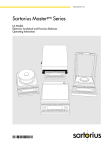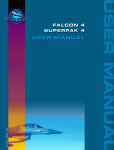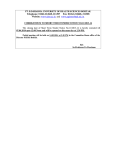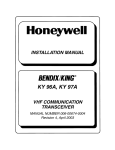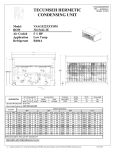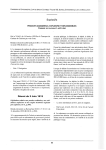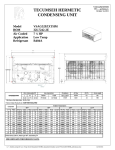Download Lake Flyer - Lake Amphibian Flyers Club
Transcript
Lake Flyer LAKE AMPHIBIAN FLYERS CLUB 7188 Mandarin Drive Boca Raton, FL 33433-7412 Edited by Marc & Jill Rodstein Phone 561-483-6566 Fax 561-892-3128 E-mail: [email protected] Members-Only Web Forum: http://forums.delphiforums.com/lakeamphibs Safety ♦ Knowledge ♦ Prof iciency Issue 06-4 Alaska Revisited, Conclusion By Rich Pellerin In the second of this 3 part series, I discussed how you can unknowingly get into trouble flying in good weather up the BC & SE Alaska coast. Flying VFR into low IFR weather is not something that you do unknowingly. You know it with at least some advance warning each time you do it. Having had to negotiate my way through ceilings as low as 100 feet and visibilities as low as ¼ of a mile over and over again, the following points need to be made. The old adage “never take your airplane where your mind hasn’t been 5 minutes before” needs to be dramatically adjusted downward to 15 seconds before. That’s about how much time you’ve got before arriving at the far forward end of your forward view in a ¼ mile visibility. It’s the visibilities, not the ceilings that get your attention. For those of you who think its illegal and suicidal to be flying in those conditions I have two responses. You’re wrong on both counts. First, in totally uncontrolled airspace, which is what you’re flying in up there, it is legal. It may ♦ Fun July-August 2006 seem counter intuitive, and is in fact an obscure and seldom cited aspect of the regs, but IFR flight in uncontrolled air space means since its uncontrolled there won’t be any other traffic on an IFR clearance. You are responsible for your own navigation and terrain and traffic avoidance. You must be instrument rated and meet recent experience requirements for IFR flight. You are technically speaking not flying by VFR rules. Second, the part 135 float plane operators, for which it is technically illegal (remember, we’re part 91) have no choice. If they didn’t venture out in these conditions on a frequent basis they simply couldn’t stay in business. Nor could the outlying logging camps, the occasional fish boat with a break down in need of a spare part, etc., continue to function. The FAA knows this and in this case wisely adopts a look the other way policy. That said, don’t kid yourself. Its very serious business. If you have any other attitude about it stay on the ground. Despite having numerous encounters with this kind of flying, my pulse always quickens and my palms always get sweaty when I first find myself once again struggling along in the gloomy world of low IFR. No one is suggesting here that you take off in it. But if you spend several days in a forest service cabin unable to see a few hundred yards out the door, when you can finally see a mile down the lake and 300 feet up the ridge bordering the lake, believe me, cabin fever will make you go. And enroute to the airport you may very well encounter that 100 foot ceiling and ¼ mile viz. However, lets first discuss getting out of the lake. Most of these lakes are near the salt water and only a few hundred feet above them. But remember, departures in bad weather absolutely and unequivocally means visually seeing the salt water at the outbound end of the lake. It may have taken you two hours to break camp, load the plane in the rain and all the rest. But if at the other end of the lake after lifting off the visibility is too low to see the salt water you must turn back to the cabin. Flying in that kind of ceiling and viz means either flying over the water or in clear view of how to get back to it at all times. No exceptions. A corollary topic is how to get into Lake Flyer 919 a lake in low ceilings and viz. At times I’ve stretched that ¼ mile viz into a ½ mile by taking ever deeper biting arcs into the terrain, always keeping the salt water in view on one side of me, up to a ¼ mile away in really low viz until I could see the lake a ¼ mile out the opposite side of the plane. Use this technique only to get into a lake you’ve been in before and are familiar with. And never close the back door behind you by loosing visual to the body of water you’re leaving until you clearly see the next body of water ahead. Having covered entry into and exit from these lakes in bad weather, lets next discuss the even more basic topic of enroute techniques for negotiating low IFR. A typical scenario is that conditions are marginal VFR and looking ahead you see a wall of white coming seemingly right down to the water. What to do? Its not necessarily time to turn back yet. First, if you haven’t already re-configured the airplane, do so now. Flaps down, mixture full rich, prop pitch flat. I usually turn the boost pump on for back up as well. Next pick up that ¼ mile turning radius off the shoreline. Now go ahead and take a shallow arcing cut into the gloom, pointing toward the shore. Come back out into the clearer air and doing a 360 arc go into the gloom again. Usually a hundred feet in the air the surrealistic world of the foggy shoreline will become visible and capable of being followed. If you lose forward visibility beyond about your 10:30 or 1:30 position depending on which side the shoreline is outside of the windshield, you can do a 180 turning towards the shore. That’s where your ¼ mile interval comes into play and that’s why you don’t want to be flying directly over the Lake Flyer 920 shoreline in these conditions. Your other option in calm water, is to set down and step taxi. Remember that you lose this second option flying along the open sea coast. Even on a calm day open sea swell is to be avoided. Usually really low viz means calm air and water. Particularly in the summer months when you’re apt to be there. Once inside the outer barrier islands step taxing is one of your options in calm water. A word about leaving that shoreline. Generally speaking, in low IFR, don’t. Once you start across a stretch of open water with no shoreline visible, it becomes very challenging to know just exactly when you’ll come up on the next shoreline, or even where it is. Navigation with two aboard is easier than being alone. The left seater then has only to fly the airplane. The right seater has the harder job of keeping the plane on the chart (i.e. not getting lost). I wouldn’t recommend taking on low IFR alone at first. But usually these days that’s the way I’m forced to deal with it. The world of yoke mounted GPS moving map displays has simplified navigation somewhat. But if you wouldn’t fly into something without it, you need to ask yourself do you really want to fly into it with it. The data base does not have every last little island with a hundred foot tall tree on it in it. And it never has the ship with the 150 foot tall mast in it. And what if you lose the signal or the box packs up? Basic pilotage skills and as always keeping your cool are necessary in these conditions. Don’t over focus on the yoke mounted GPS (and don’t have it anywhere else but in your line of vision on the yoke). Your eyes should be focused outside most of the time, momentarily checking the display (set up with a half mile diameter circle having your plane moving through it in the middle of it in a ¼ mile viz) only to confirm your position. Always have the sectional on your lap ready to be viewed if necessary. I carry a marine hand held VHF radio on board. Once down on the water in this kind of weather the ability to communicate with a passing boat comes in very handy. If you’re in some kind of difficulty its nice to be able to talk to the Coast Guard too. The last topic to be discussed is your windshield. Any flying boat or twin engine plane on floats operates under the distinct disadvantage of not having prop wash on the windshield. This tends to work against you especially in heavy precip. A number of measures need to be taken. Maintain your heater and keep it on to dry the air on your side of the windscreen. Always apply the treatment of your choice to bead up and disperse the water on the wind shield and keep it freshly applied. Lastly, never venture into low IFR without a roll of paper towels at hand to periodically, especially until the cabin warms up, wipe clean the moisture off the windshield. I don’t find the defroster fan of much use in these conditions. I’ll close this last and longest of the three part series by warning you that no matter how sorely you are tempted to climb up into that gloom and file IFR, don’t with rare exception even think about it. The instrument approaches are hundreds of miles apart in places, often have high minimums, and there’s a lot of cumulus granitidus between you and them. The icing and turbulence up there are legendary. Get into it and you’ve crossed off your last option, namely landing on the water. Deal with what you have down on the deck. Over a decade ago I heard about a flight of 6 or 7 Lake Amphibs flying north to Alaska. Apparently each night they stayed in town in motels. I don’t know whether or not they actually landed in any lakes or not. Most water destinations would never have room to park that many planes in front of a forest service cabin anyway. Unless I miss my guess, its also probably the case that they only ventured into the air in good weather. That’s one way of doing the trip. In this series of articles I’ve described another way of doing it. If you do it my way, no matter how many times you do it, think of yourself like I do. Up there you’re nothing more than a serious beginner. There’s always something new to learn. Just hope its not your final lesson. Editor’s note: Some of you may have read the foregoing and scratched your head thinking: How can what Pellerin describes be legal? Read the letter below from an official FAA source. It’s an eye opener. Zero-Zero without a Clearance? December 31, 1975 Israel Golden, Esq. Dear Mr. Golden: This is in reply to your letter of November 11, 1975 to Mr. George L. Thompson of our New England Regional Office, in which you asked whether flight within uncontrolled airspace under 700 feet above ground level in clouds (zero-zero visibility) by an instrument rated pilot is permissible under the Federal Aviation Regulations without a clearance from ATC. The regional counsel has advised us, subsequently, that you are concerned, primarily, as to whether a pilot meeting all of the certification and recent flight experience requirements for instrument flight may take off or land under less than VFR minimums in uncontrolled airspace without an ATC clearance. The minimum altitudes for IFR operations in all airspace are governed by Section 91.119. That section states that, unless the applicable minimum altitude is prescribed in Parts 95 or 97, or is otherwise authorized by the administrator, no person may operate an aircraft under IFR below 1000 feet (or 2000 feet over an area designated as mountainous in Part 95) above the highest obstacle within a horizontal distance of five statute miles from the course to be flown, except when necessary for takeoff or landing. Section 91.115 provides that no person may operate an aircraft in controlled airspace under IFR unless he has filed an IFR flight plan and has received an appropriate ATC clearance. No corresponding regulation requires an ATC clearance for IFR flight in uncontrolled airspace, nor does any regulation prohibit landing or taking off in uncontrolled airspace under IFR. It is also clear that flight within uncontrolled airspace under IFR is not prohibited (for example Section 91.12(b) prescribes IFR cruising altitude for such operation). In view of the foregoing, we conclude that under Part 91, the general rule is that a person meeting the pilot certification and recent experience requirements for IFR, operation may operate an aircraft under 700 feet in uncontrolled airspace, under IFR, without an ATC clearance, when necessary for takeoff and landing. However, this does not preclude the possibility that, in a given factual situation, such operation may be deemed careless or reckless so as to endanger the life or property of another., in violation of Section 91.9, or may violate other specific provisions such as restricted areas. Sincerely, Richard W. Danforth Chief, Airspace, Air Traffic & Environmental Quality Branch, Regulations Division Office of the Chief Counsel Lake Flyer 921 Lake Central Approval Gets European The European Aviation Safety Agency has issued a Supplemental type Certificate to Lake Central approving the installation of their horizontal tail stabilizer fitting kits. Now the benefits of this modification are available to European registered Lakes. For more information, contact Lake Central at 705-687-4343. Lakeathon Moved to April In response to strong pressure by members, we are moving the dates of Lakeathon 2007 to April 13-16. Historically Lakeathon has always been held in February, but many members have requested that we reschedule it to a time that will allow Lakeathon attendees to also attend Sun-N-Fun on the same trip. Many members travel long distances to get to Florida and have a desire to “kill two birds with one stone. Although an informal vote at Lakeathon 2006 was narrowly in favor of retaining the traditional schedule, in an online poll held on our web forum, 59 out of 65 people voting wanted it held in conjunction with Sun-N-Fun. So despite some reservations over the difficult logistics of holding our convention at the same time that thousands of airplanes are converging on the area from all over North America, we are going to give it a try and see how it works out. Mark your calendars for April 1317, 2007. We will have a Friday arrival, and our activities will end on Monday April 16th, the day before Sun-N-Fun begins. Along with the Sun N Fun tie-in, we can be pretty sure that the weather will Lake Flyer 922 not be cold (as recent Lakethons tended to be). But there are negatives. The weather may be hot, as April can be in Florida. Facilities of all kinds will be under stress, because many other groups of pilots will be converging on the area at the same time. Rates for hotels and cars will be higher. You will have to book earlier to get hotel rooms and restaurant reservations, and ramp space at Bartow, Winter Haven and other area airports will be limited, with overflow-type parking likely. When the crunch comes remember, you asked for this! We estimate that our block of rooms at the Holiday Inn in Winter Haven (site of Lakeathon activities) will sell out before the reservation cutoff date of March 21, 2007. Don’t be left behind, call early for your reservations. Now would be a good time. You need to phone the hotel directly, not the 800 number, to get the Lake Flyers rate of $72 per night. This rate will be available from April 10- April 18. If you wish to arrive earlier or stay later, you must reserve those dates separately subject to availability and at prevailing rates. To reserve, contact the Holiday Inn directly at (863) 294-4451. There is no telling how long our block of rooms will last, and alternate space in the area will be hard to find due to Sun-N-Fun. Details about club registration for Lakeathon will be provided in an upcoming issue. Preflight Notes By John Staber, Lake CFI On preflight, don’t overlook the following: Starting with the floats - water and FUEL if you have float tanks Nose plugs - water only - no other lines in these compartments Tail plugs - water and hydraulic fluid - the hydraulic lines and actuator for the trim are in this section Step plug -water, fuel, hydraulic fluid, battery acid along with other detritus that filters down into the main hull from the cockpit area such as sand, coins, bits of insulation. All of the systems have lines in this area which could have a seeping fitting or a split line due to water freezing. This includes, fuel and oil pressure, manifold pressure, pitot and static, brakes, gear and flap up and down, trim actuator and lines. Remember also that rain water can enter this compartment and freeze. If the level is high enough it will freeze around the bell cranks that work the elevator and rudder rendering them inoperable. THERE HAS BEEN MORE THAN ONE INCIDENCE OF THIS HAPPENING IN FLIGHT. A simple check by inserting the long end of the plug wrench in the hole will tell you if you have this condition. It will also dislodge anything blocking the hole allowing it to drain again. There are weep holes between the bulkheads to allow fluids to run aft to the step, but if plugged with junk they are useless. Needless to say, keep your bottom clean! PanAm Flying Boat, part 2 Conclusion of The Round The World Saga of the "Pacific Clipper" John A. Marshall. Continued from Issue 06-3. The first installment of our story ended with the crew of the Clipper contemplating their takeoff from the Nile River and the safety of British-held territory, to continue their journey westward across uncharted territory. Early the next morning they took off from the Nile for Leopoldville. This was to be a particularly long overland flight, and they wanted to leave plenty of daylight for the arrival. They would land on the Congo River at Leopoldville, and from there would strike out across the South Atlantic for South America. The endless brown of the Sudan gave way to rolling green hills, and then rocky crests that stretched across their path. They flew over native villages, and great gatherings of wildlife. Herds of wildebeest, hundreds of thousands strong, stampeded in panic as the Clipper roared overhead. The grassland soon turned to jungle, and they crossed several small rivers, which they tried to match to their maps. Suddenly ahead they saw a large river, much bigger and wider than others they had crossed, and off to their right was a good-sized town. The river had to be the mighty Congo, and the town was Bumba, the largest settlement on the river at that point. From their maps they saw that they could turn and follow the river downstream to Leopoldville. They had five hundred miles to fly. Late in the afternoon they raised the Congolese capital of Leopoldville. Ford set the Boeing down gently onto the river, and immediately realized the strength of the current. He powered the ship into the mooring, and the crew finally stepped ashore. It was like stepping into a sauna. The heat was the most oppressive they had yet encountered; it descended on them like a cloak, sapping what energy they had left. A pleasant surprise awaited them however, when two familiar faces greeted them at the dock. A Pan American Airport Manager and a Radio Officer had been dispatched to meet them, and Ford was handed a cold beer. "That was one of the high points of the whole trip," he said. After a night ashore they went to the airplane the next morning prepared for the long over-water leg that would take them back to the western hemisphere. The terrible heat and humidity had not abated a bit when the hatches were finally secured and they swung the Clipper into the river channel for the takeoff. The airplane was loaded to the gunnels with fuel, plus the drum of oil that had come aboard at Noumea. It was, to put it mildly, just a bit overloaded. They headed downstream into the wind, going with the six-knot current. Just beyond the limits of the town the river changed from a placid downstream current into a cataract of rushing rapids; pillars of rocks broke the water into a tumbling maelstrom. Ford held the engines at takeoff power, and the crew held their breath while the airplane gathered speed on the glassy river. The heat and humidity, and their tremendous gross weight were all factors working against them as they struggled to get the machine off the water before the cataracts. Ford rocked the hull with the elevators, trying to get the Boeing up on the step. Just before they would enter the rapids and face certain destruction, the hull lifted free. The Pacific Clipper was flying, but just barely. Their troubles were far from over, however. Just beyond the cataracts they entered the steep gorges; it was as though they were flying into a canyon. With her wings bowed, the Clipper staggered, clawing for every inch of altitude. The engines had been at take-off power for nearly five minutes and the their temperatures were rapidly climbing above the red line; how much more abuse could they take? With agonizing slowness the big Boeing began to climb, foot by perilous foot. At last they were clear of the walls of the gorge, and Ford felt he could pull the throttles back to climb power. He turned the airplane toward the west and the Atlantic. The crew, silent, listened intently to the beat of the engines. They roared on without a miss, and as the airplane finally settled down at their cruising altitude Ford decided they could safely head for Brazil, over three thousand miles to the west. The crew felt revived with new energy, and in spite of their fatigue, they were excitedly optimistic. Against all odds they had crossed southern Asia and breasted the African continent. Their airplane was performing better than they had any right to expect, and after their next long ocean leg they would be back in the hemisphere from which they had begun their journey nearly a month before. The interior of the airplane that had been home to them for so many days was beginning to wear rather thin. They were sick of the endless hours spent droning westward, tired of the apprehension of the unknown and frustrated by the lack of any real meaningful news about what was happening in a world besieged by war. They just wanted to get home. After being airborne over twenty hours, they landed in the harbor at Natal just before noon. While they were waiting for the necessary immigration formalities to be completed, the Brazilian authorities insisted that the crew disembark while the interior of the airplane was sprayed for yellow fever. Two men in rubber suits and masks boarded and fumigated the airplane. Lake Flyer 923 Late that same afternoon they took off for Trinidad, following the Brazilian coast as it curved around to the northwest. It wasn't until after they had departed that the crew made an unpleasant discovery. Most of their personal papers and money were missing, along with a military chart that had been entrusted to Navigator Rod Brown by the US military attach in Leopoldville, obviously stolen by the Brazilian "fumigators." The sun set as they crossed the mouth of the Amazon, nearly a hundred miles wide where it joins the sea. Across the Guineas in the dark they droned, and finally at 3 AM the following morning they landed at Trinidad. There was a Pan Am station at Port of Spain, and they happily delivered themselves and their weary charge into friendly hands. The significance of the flight is best illustrated by the records that were set by Ford and his crew. It was the first round-the-world flight by a commercial airliner, as well as the longest continuous flight by a commercial plane, and was the first circumnavigation following a route near the Equator (they crossed the Equator four times.) They touched all but two of the world's seven continents, flew 31,500 miles in 209 hours and made 18 stops under the flags of 12 different nations. They also made the longest non-stop flight in Pan American's history, a 3,583 mile crossing of the South Atlantic from Africa to Brazil. The final leg to New York was almost anti-climactic. Just before six on the bitter morning of January 6th, the control officer in the Marine Terminal at LaGuardia was startled to hear his radio crackle into life with the message, "Pacific Clipper, inbound from Auckland, New Zealand, Captain Ford reporting. Overhead in five minutes." As the war progressed, it became clear that neither the Army nor the Navy was equipped or experienced enough to undertake the tremendous amount of long distance air transport work required. Pan American Airways was one of the few airlines in the country with the personnel and expertise to supplement the military air forces. Captain Bob Ford and most of his crew spent the war flying contract missions for the US Armed Forces. After the war Ford continued flying for Pan American, which was actively expanding its routes across the Pacific and around the world. He left the airline in 1952 to pursue other aviation interests. In a final bit of irony, after over thirty thousand miles and two hundred hours of flying on their epic journey, the Pacific Clipper had to circle for nearly an hour, because no landings were permitted in the harbor until official sunrise. They finally touched down just before seven, the spray from their landing freezing as it hit the hull. No matter -- the Pacific Clipper had made it home. The Crew of Pacific Clipper: Captain Robert Ford First Officer John H. Mack Second Officer/Navigator Roderick N. Brown Third Officer James G. Henriksen Fourth Officer John D. Steers First Engineer Homans K. "Swede" Roth Second Engineer John B. "Jocko" Parish First Radio Officer John Poindexter* Second Radio Officer Oscar Hendrickson Purser Barney Sawicki Asst Purser Verne C. Edwards. Lake Flyer 924 * Poindexter was originally scheduled to accompany the Pacific Clipper as far as Los Angeles, and then return to San Francisco; he had even asked his wife to hold dinner that evening. In Los Angeles, however, the regularly scheduled Radio Officer suddenly became ill, and Poindexter had to make the trip himself. His one shirt was washed in every port that the Pacific Clipper visited. This article originally appeared in the August 1999 Issue of "Air and Space Magazine" and is reprinted by permission of the author. A Bit of Lake History Or, The Iraq Connection (Reminiscing with Lake old-timers John Staber and Paul Furnee) Staber: There was a certain pilot who worked for Lake one winter and a certain Italian water skier that owned a Lake, and a certain film company that was making an Italian "That’s incredible!" TV show. It was on the lake that Cypress Gardens is on. It took two lengths of rope. They made eight passes up the lake at 10' in the air, each time landing at the north end and pulling the skier right up to the floating platform on the step. The last one was a bit different as it was directly into the setting sun. Said skier dropped rope before the aircraft had landed. Each time the handle dug into the water it was like someone threw out the anchor. Descent was made adding a wee bit of power while the handle was submerged, and reducing when it was in the air. A fine landing was made. The pilot says that for the most part there was no indication that there was anyone trailing behind. The skier was on the step before the airplane. Nice EP that went to Iraq. I suppose if one wanted to make a case, it could be reckless op. All it really needs is one neighbor making a phone call to "you know who". Furnee: The two aircraft that went to Iraq were N8014R and N8014Y, probably s/n 1080 and 81. The water ski one was N8014Y which I ferried from Sanford to Kissimmee over Christmas week, 1982. Horrible weather the whole trip. Spent hours on Lake George in the middle of a restricted zone in FL waiting for the ceiling to lift. Red and gray. 14R was what we called the blackwatch plaid. Metallic green and blue. Looked great in the flesh but didn't photograph well at all. An Iraqi named Sarkisse (sp?) supposedly bought them as a gift for Saddam and both were flown to Miami and dismantled and put on a jet. Someone from Lake went to Iraq to put them back together and I think Luke Smith went over to finish the training of his pilot, a huge hulk of a man that looked like a bodyguard. Kind of scary to be around. Armand was in his glory. I had heard the same story about one meeting its demise and the other not. But that is all I know. If you can come across a copy of the Italian "That's Incredible!" I would be forever indebted. It's great to look back in the logbook and revive these memories. In the process I noticed that during that time I flew the same two aircraft that I trained in last summer, N8009X (Barbara Fioravanti) and N8013U (Pete Nelson). High Density Altitudes By Paul Furnee, Lake CFI Most important at high altitudes is temperature. It makes an amazing difference. Make sure you can get an accurate DENSITY altitude report or can calculate it yourself. On land, DENSITY altitudes of up to 6,000 ft. are not too much of problem, even at gross weight, if you have a 5000 ft runway and no big obstructions. But as you approach 9,000 ft. things really begin to sag. You will get off the ground maybe at the 3000 ft mark, but at the end of a 6,000 runway you will be lucky to have 50' AGL. as up. Suggestions: Q: The "O" ring on one of my "mains" started leaking - appears to have rolled a bit in the grove. The "O" ring that was in there, and the only ones I could find at any of our local aviation parts houses (Ace Hardware Aviation Parts, Hunt's True Value Hardware Aviation Parts, Napa Aviation Parts, etc. ) are ROUND "O rings just like the one that I found in there damaged from being "rolled". 1. BEFORE starting the take off and as part of the runup, do a FULL THROTTLE run up, and adjust the mixture for best power. That is typically about 125 degrees rich of peak. Note, since you cannot get anywhere near 100% power at this altitude, there is NO HARM in running at peak EGT for up to a minute or so, even on the ground. 2. Don't rush things. Let the aircraft accelerate to a clean lift off speed (65 MPH if you have enough runway). DO NOT TRY TO ROTATE EARLY! It will do nothing but extend your take off run. 3. Climb at at least 68 MPH unless obstacles cannot be avoided. In this case, airspeed is your friend rather than altitude, since you cannot get altitude in any case. More than one Lake has flown into the ground after getting behind the power curve (too slow) trying to climb and then encountering a downdraft. 4. DON'T be in a rush to retract the flaps. Leave them down until 500' AGL just like you should do at S/L. The aircraft will climb just as fast with the flaps down 5. Avoid obstacles by a wide berth and ALWAYS leave yourself an out like a river valley to recover airspeed if you need it. NEVER try to cross a ridge or hill without at least a 1000' margin, more if it is windy. 6. Enjoy the flight! ASK THE EXPERT “O”-Rings and Oleos. From the Service Manual, it LOOKS like there might have been a SQUARE "O" ring that filled the entire machined grove. The machined grove is a bit too wide for the “O” ring that I found in there - again, identical to the one I bought. What's the deal here ? Is there a spacer that should have been in there ? Or a wider "square" “O” ring? 2) The more air and the less oil you have as an aircraft shock absorber/oleo, the smoother the ride. I routinely operate off runways that would scare a dune buggy. Has anyone tried putting LESS oil and MORE air in their shock absorbers, than the service manual calls for ? The way the manual sets em up, they are pretty stiff. Lake Flyer 925 Answers by Paul Furnee: 1. O-rings are not square. They are round. The correct O-ring is indeed round. But as you have so astutely discovered, the groove is too wide. Welcome to the world of Lakes. There is a long story about why, but it doesn't really matter at this point. Get yourself an MS28994-xxx back up ring with the same dash number as the O-ring and use it as a spacer. That will take up the extra slop in the groove and keep the O-ring from rolling and subsequently tearing. 2. Don't try to re engineer the shock system. It was designed for rough roads and runways. The nose is ALWAYS stiff and should be that way until you load two big mules like me in the front seat. Then it will be nice and squishy. The mains, if you go by the service manual, don't have enough air in them for normal operations, but that's the only way they could pass the "drop test", so if you service them according to the manual, you can sue Armand if the gear fails on one of your "drop in" landings. Most people don't go by pressure, but by the amount of oleo strut showing when parked. Typically it is 3.5". Fly-In Destinations Northern Lake Amphibian Pilots' Fly-In, September 7 to 10, 2006. Killarney Mountain Lodge, Killarney, Ontario. Killarney is situated on the beautiful northern shores of Georgian Bay. There is something for everyone. Expert LAKE information will be gained from Elton Townsend, Harry Shannon and Jim Hodgson. These specialists will host seminars as Lake Flyer 926 well as question and answer sessions on the mechanical and flying techniques Lake pilots need. Companion sessions run concurrently. Come meet some new people and see ol' friends. See www.northernlakeamphibianpilots.c om or email [email protected]. Red Pines Bed & Breakfast On Lake Pleasant, Speculator, NY. Warm hospitality in Adirondack elegance. Park your plane on the beach or the ramp. Fuel nearby at Piseco NY airport (K09). www.redpinesbb.com 518-5485382 . For Sale 1980 LA-4 200 738 TT since new A&E. Bat wings, Aux Fuel, Hull Boosters, No Salt, Hangar kept in Alaska, Deliver for cost, CFI owner. $82,500. Questions? Email [email protected] or 907-223-5270 Steel Landing Mat, 45 pieces that interlock and make a 60 foot by 20 foot ramp. We just sold our LA4200 and removed from the lake. It was an excellent ramp. Will sell for $1000. 863-602-9182, email [email protected]. FOR SALE: 1982 LA4-200 Ser. 1066. Off-white with maroon and blue trim, repainted in 2000. 3200TT, 900 SMOH. KNS-80, KMA-24 with marker beacon; KY197 flip-flop comm.; KT-76A transponder with altitude encoding; KI-206 glide slope on #1 Nav head; New Strikefinder, Good IFR bird! Door struts, fuel quantity/flow /pressure gauge, and many other extras. Fresh annual, all but one annuals by Shannon or Furnee. $86,000. Located in Siren, Wisconsin. Fred Weber, 715-8665290. CLAIMS AND DISCLAIMS ©Copyright 2006 LAFC. All rights reserved. This publication is not to be copied or redistributed by any means in whole or in part for any reason without advance written authorization from LAFC. It is restricted to the individual persons to whom it is initially sent by the Club. Read it and retain it that's all. We disclaim any representation or warranty express or implied, concerning published data or communications: and in no event shall we be liable for any loss or damage claimed to have arisen as a result of their use. Readers must accept full responsibility for their own interpretations, decisions and activities, whether or not inspired in any way by the club, its members, writers, editors, personnel, communications or publications. It is all "hangar flying," mere snapshots of casual continuing conversations expressing beliefs, opinion and thought between club members. Therefore, it must not be accepted as authoritative, factual, safe or reliable. It's never the last word. Submissions subject to revision, editing, rejection. Opinions stated by those other than the publisher are printed as the personal opinion of the writer or the person quoted, and do not necessarily represent the opinion of the publisher. LAKE FLYER is published six times a year by the Lake Amphibian Flyers Club division of Equicorp Financial Corp, 7188 Mandarin Drive, Boca Raton FL 33433-7412. Phone 561483-6566. Fax 561-892-3128. E-mail: [email protected]. Everyone is eligible for membership. Initial or reinstatement fee US$88 includes one year dues of $58. Add US$ 10 for mailing outside Canada or US to cover Air Mail. Pay in US funds drawn on US or Canadian bank only. Sorry, no credit cards. Previous issues of LAKE FLYER wil be sold to members only, for their personal use. Call, e-mail or fax for availability and prices. Not affiliated with any manufacturers or marketers. aircraft









